
The 5d value was not issued until April 1922 with the Edward VII issue remaining in use until then.
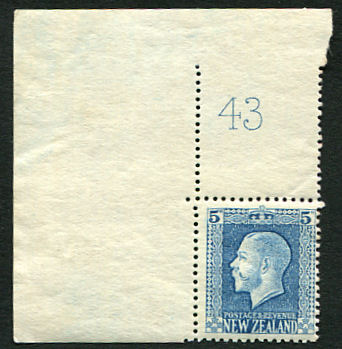
The colour was light blue until 1930 when the colour was changed to pale ultramarine. Then, in March 1932, a further change was made to steel blue.
The plate had number 43. Like the later plates in the other values, the impressions were not as deep as in the original 1915 plates. Hence, even in the early printings, the stamps appear slightly worn.
By the time the colour was changed to steel blue, the impressions were quite worn especially above POSTAGE & REVENUE as can be seen below.
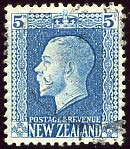
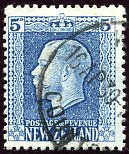
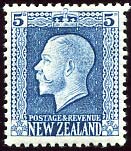
light blue, pale ultramarine and steel blue
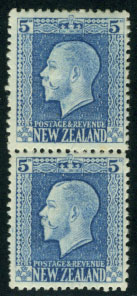
Two Perf Pair
Pale Ultram
Some of the first printing in 1922 was perforated 14 x 14½ but the great majority of the stamps in light blue were perforated 14 x 13½.
The first printing in pale ultramarine was perforated 14 x 14½ in the top 5 rows and 14 x 13½ in the lower 5; later printings were perforated 14 x 13½ throughout. The 14 x 13½ perforation continued with the steel blue printings until March 1934 after which the sheets were perforated 14 x 14½.

early postmark
The CP catalogue states that the pale ultramarine shade first appeared in May 1930 although the The Postage Stamps of New Zealand Vol 1 only states 'early 1930'. The illustrated ultramarine stamp is perforated 14 x 14½ and clearly shows the postmark 16 AP 30.
A study of GV shades by Dr White in 1990 [1] mentions an example postmarked in January 1930
and so the May 1930 is too late.
The above information is taken from
The Postage Stamps of New Zealand Vol 1, published by
the
Royal Philatelic Society of New Zealand in 1938.
[1] A Dating Study of GV Shades, Part 2, G. White,
C.P. Newsletter, vol 42, no.4, pp 4-8, November 1990. (Available in the Research archive section
of the New Zealand Society of Great Britain at www.nzsgb.org.uk )
All scans were made by the author.